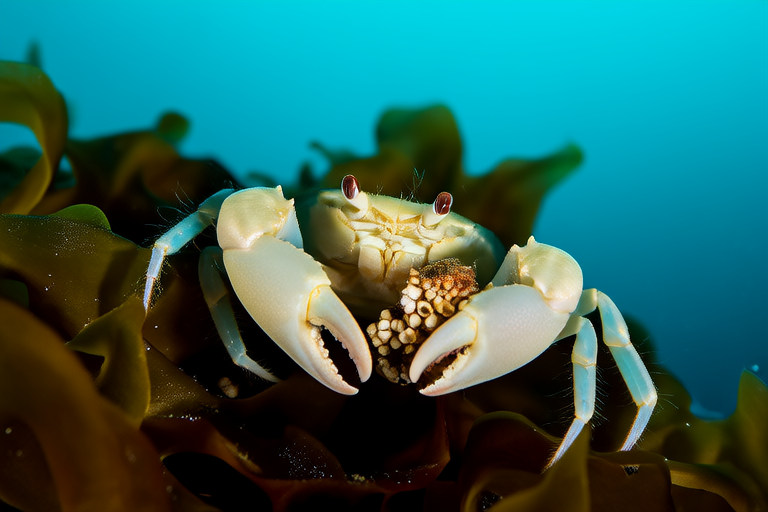From Sea to Table: Discovering the Unique Life of Pea Crabs
Pea crabs (Pinnotheres spp.) are tiny crustaceans that inhabit various marine environments worldwide. Despite their diminutive size, pea crabs play a significant role in marine ecosystems, particularly in their symbiotic relationships with larger organisms. This article explores the fascinating life of pea crabs, from their anatomy and reproduction to their symbiotic partnerships and the challenges they face in their environment.
The Tiny Titans of the Marine World
Pea crabs are among the smallest crabs, measuring less than half an inch (1 cm) in length. Their small size allows them to thrive in crevices and interstices of marine environments, making them well-adapted to living inside bivalves like mussels and clams. These habitats provide protection from predators and offer a steady supply of nutrients through the filtration feeding of their hosts.
Symbiotic Partnerships: A Mutualistic Relationship
Pea crabs have evolved a remarkable symbiotic relationship with certain marine animals, primarily bivalves and sea cucumbers. In these partnerships, pea crabs reside within the mantle cavity of their host, where they consume detritus and plankton filtered by the host’s gills. In return, the pea crab provides its host with protection against parasites and predators. The relationship is mutually beneficial, enhancing the survival chances of both species.
The symbiosis between pea crabs and mussels is particularly notable. Pea crabs can be found in the gill chambers of mussels, where they feed on the plankton that the mussel filters from the water. This arrangement not only ensures a steady food supply for the pea crab but also helps to clean the gills of the mussel, potentially improving its respiration efficiency. Similarly, pea crabs living within sea cucumbers benefit from the host’s protection while aiding in the removal of parasites.
Anatomy and Reproduction
Pea crabs possess a streamlined body structure that facilitates their life within the confined spaces of their hosts. They have soft, flexible bodies covered in fine hairs, which help them move through the narrow passages of their hosts. Unlike many other crab species, pea crabs lack claws, which would hinder their movement within tight spaces.
The reproductive cycle of pea crabs is closely tied to the lifecycle of their hosts. Females carry their eggs under their bodies until they hatch. Once hatched, the larvae disperse into the water column, where they undergo several stages of development before settling onto a suitable host. The timing of this process is crucial, as the larvae must find a host during a specific developmental stage to ensure successful integration.
Unique Adaptations for Survival
Pea crabs have developed several adaptations that enhance their survival in challenging marine environments. Their flattened bodies allow them to maneuver easily within the confines of their hosts, while their soft exoskeletons enable them to grow and adapt to changes in their surroundings. Additionally, pea crabs are capable of molting their exoskeletons multiple times throughout their lives, allowing them to continue growing even after reaching adulthood.
These crabs also exhibit a remarkable ability to adjust to varying salinity levels, which is crucial given the fluctuating conditions within their hosts. This adaptability ensures that pea crabs can thrive in diverse marine environments, from estuaries to open oceans.
Challenges in the Marine Environment
Despite their adaptations, pea crabs face numerous challenges in their environment. Predation remains one of the most significant threats, with larger marine creatures such as fish and octopuses preying upon them. To mitigate this risk, pea crabs rely heavily on their hosts for protection, seeking refuge within the shells or bodies of their symbiotic partners.
Climate change poses another significant threat to pea crabs. Rising ocean temperatures and acidification can disrupt the delicate balance of marine ecosystems, affecting the availability of suitable hosts and altering the conditions necessary for successful reproduction. As global temperatures continue to rise, it is essential to monitor the impact on pea crab populations and their symbiotic relationships.
Cultural Significance and Culinary Uses
While pea crabs may not hold significant cultural importance in many parts of the world, they do play a role in some culinary traditions. In Japan, for example, the presence of pea crabs in oysters is considered a delicacy. Known as shirako, the eggs of the pea crab are highly prized for their texture and flavor. Chefs carefully extract the eggs from the oyster and serve them as a gourmet dish, highlighting the intricate connections between marine life and human culture.
Moreover, the study of pea crabs contributes to our understanding of marine ecosystems and the complex relationships that exist within them. By examining these tiny creatures, scientists gain valuable insights into the broader ecological dynamics of the oceans, informing conservation efforts and sustainable management practices.
Conclusion
Pea crabs are more than just tiny inhabitants of marine environments; they are integral components of complex symbiotic relationships that support the health and diversity of marine ecosystems. Through their unique adaptations and mutualistic partnerships, pea crabs exemplify the resilience and ingenuity of life in the oceans. Understanding their role in marine ecology not only enhances our appreciation for the natural world but also underscores the importance of preserving these delicate ecosystems for future generations.
